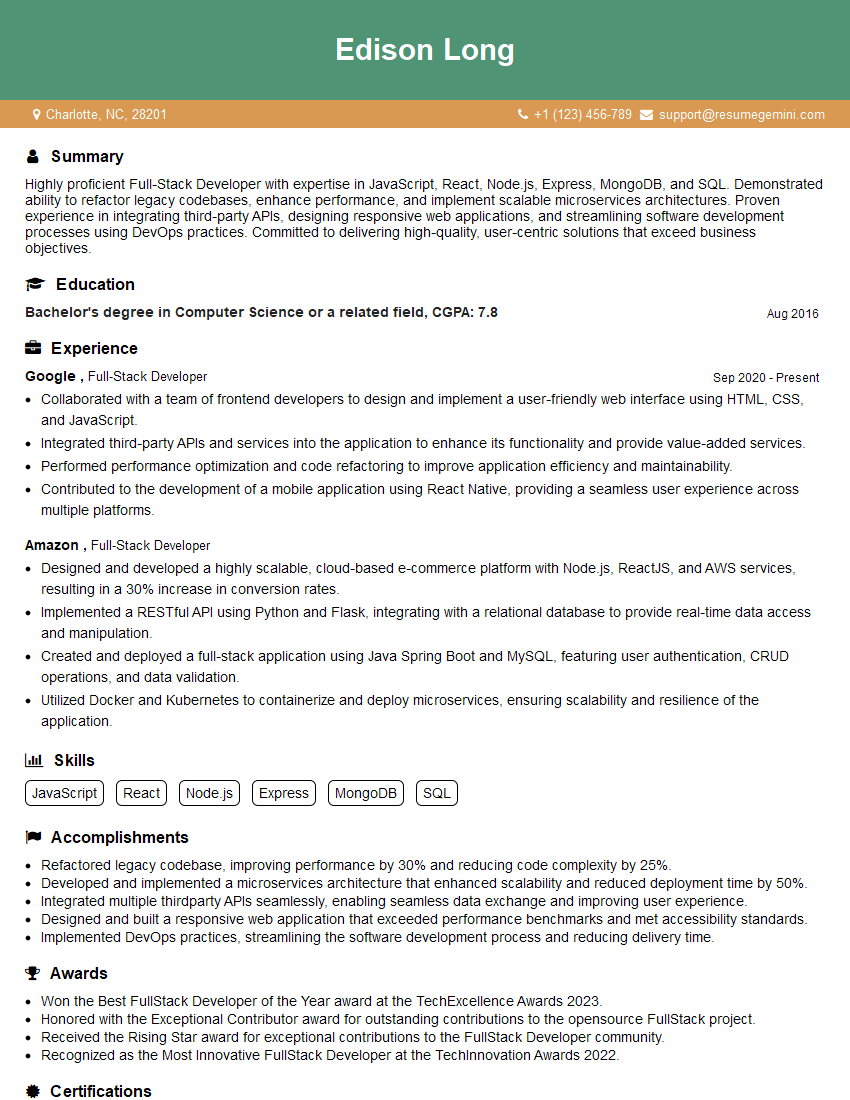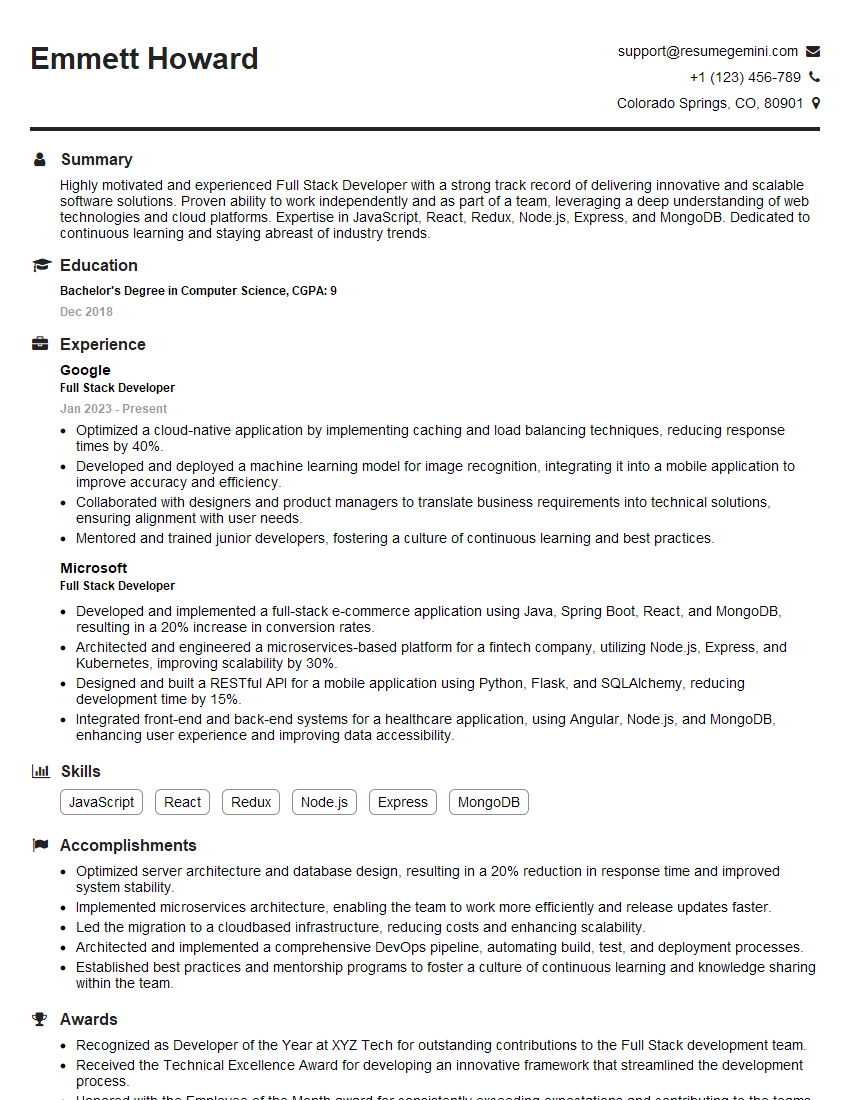Are you gearing up for a career shift or aiming to ace your next interview? Look no further! We’ve curated a comprehensive guide to help you crack the interview for the coveted Full-Stack Developer position. From understanding the key responsibilities to mastering the most commonly asked questions, this blog has you covered. So, buckle up and let’s embark on this journey together.
Acing the interview is crucial, but landing one requires a compelling resume that gets you noticed. Crafting a professional document that highlights your skills and experience is the first step toward interview success. ResumeGemini can help you build a standout resume that gets you called in for that dream job.
Essential Interview Questions For Full-Stack Developer
1. Design a database schema for a simple e-commerce website that sells products and has kullanıcıs with orders. The schema should include tables for products, kullanıcıs, orders, and order details.
Database Schema:
- Products Table:
- product_id (Primary Key)
- product_name
- product_description
- product_price
- Kullanıcıs Table:
- kullanıcı_id (Primary Key)
- kullanıcı_name
- kullanıcı_email
- kullanıcı_password
- Orders Table:
- order_id (Primary Key)
- order_date
- order_total
- kullanıcı_id (Foreign Key)
- Order Details Table:
- order_detail_id (Primary Key)
- order_id (Foreign Key)
- product_id (Foreign Key)
- quantity
- unit_price
2. How do you handle user authentication and authorization in a full-stack application?
Authentication:
- Use a secure authentication mechanism such as JWT (JSON Web Tokens) or OAuth2.
- Implement user registration and login endpoints.
- Store user credentials securely (e.g., hashed passwords).
Authorization:
- Define user roles and permissions.
- Use middleware or access control mechanisms to restrict access to resources based on user roles.
- Implement authorization logic in both the frontend and backend.
3. Explain the difference between a relational database and a NoSQL database.
- Relational Database:
- Uses a structured schema with tables and relationships
- Supports ACID (Atomicity, Consistency, Isolation, Durability) properties
- Suitable for data that needs to be highly structured and maintain relationships
- NoSQL Database:
- Uses a flexible schema (e.g., document, key-value, column-family)
- Often provides high scalability and performance
- Suitable for data that is unstructured or has complex relationships
4. Describe the principles of RESTful API design.
- Use of HTTP verbs (GET, POST, PUT, DELETE) for CRUD operations.
- Standard HTTP status codes to indicate success or errors.
- Resource-oriented URLs (e.g., /products/:id)
- Uniform interface for predictable behavior across different API endpoints.
- Support for data formats such as JSON or XML.
5. How do you implement error handling in a full-stack application?
- Define custom error classes to handle specific errors.
- Use try-catch blocks to handle exceptions and return meaningful error messages.
- Implement middleware to catch unhandled errors and log them.
- Display user-friendly error messages to the frontend.
- Consider using a third-party error monitoring tool.
6. Explain the concept of dependency injection.
- Inversion of control technique where dependencies are provided to objects rather than hard-coded.
- Allows for loose coupling and easier testability.
- Can be implemented using frameworks like Spring or Node.js dependency injection containers.
7. How do you optimize the performance of a React application?
- Use performance profiling tools to identify bottlenecks.
- Implement lazy loading and code splitting to reduce bundle sizes.
- Optimize component rendering using techniques like memoization and shouldComponentUpdate.
- Use component lifecycle methods efficiently.
- Consider using a state management library like Redux for efficient state management.
8. Describe the role of Docker in a full-stack development workflow.
- Provides a containerized environment for development and deployment.
- Ensures consistent environments across different machines.
- Facilitates easy deployment and scalability.
- Supports continuous integration and continuous delivery pipelines.
- Simplifies version control and collaboration.
9. Explain how you would approach testing a full-stack application.
- Write unit tests for individual components.
- Use integration tests to test interactions between components and the backend.
- Perform end-to-end testing to simulate real user scenarios.
- Use automated testing tools and frameworks.
- Consider using behavior-driven development (BDD) for easy-to-understand test cases.
10. How do you stay up-to-date with the latest technologies and best practices?
- Attend conferences and workshops.
- Read industry publications and blogs.
- Contribute to open-source projects.
- Join online communities and forums.
- Participate in hackathons and coding challenges.
Interviewers often ask about specific skills and experiences. With ResumeGemini‘s customizable templates, you can tailor your resume to showcase the skills most relevant to the position, making a powerful first impression. Also check out Resume Template specially tailored for Full-Stack Developer.
Career Expert Tips:
- Ace those interviews! Prepare effectively by reviewing the Top 50 Most Common Interview Questions on ResumeGemini.
- Navigate your job search with confidence! Explore a wide range of Career Tips on ResumeGemini. Learn about common challenges and recommendations to overcome them.
- Craft the perfect resume! Master the Art of Resume Writing with ResumeGemini’s guide. Showcase your unique qualifications and achievements effectively.
- Great Savings With New Year Deals and Discounts! In 2025, boost your job search and build your dream resume with ResumeGemini’s ATS optimized templates.
Researching the company and tailoring your answers is essential. Once you have a clear understanding of the Full-Stack Developer‘s requirements, you can use ResumeGemini to adjust your resume to perfectly match the job description.
Key Job Responsibilities
Full-Stack Developers are highly skilled professionals who are responsible for handling all aspects of software development, from frontend design to backend coding. Their key job responsibilities include:
1. Front-End Development
Designing and developing user interfaces, including layouts, graphics, and functionality.
- Creating responsive designs that adapt to different devices and screen sizes.
- Implementing interactive elements such as forms, menus, and buttons.
2. Back-End Development
Developing and maintaining server-side code, including business logic, data access, and system integration.
- Writing code in languages such as Java, Python, or C#.
- Designing and implementing databases to store and manage data.
3. Full-Stack Integration
Collaborating with other developers to ensure seamless integration between the front-end and back-end.
- Creating APIs and services to connect the different components of the system.
- Testing and debugging code to ensure the application functions as intended.
4. Quality Assurance
Conducting unit testing, integration testing, and system testing to identify and fix bugs.
- Using automated testing tools to ensure code quality and reliability.
- Writing documentation and creating user guides for the software application.
Interview Tips
Interviewing for a Full-Stack Developer position can be challenging, but by following these tips, you can increase your chances of success:
1. Research the Company and Position
Before the interview, take the time to thoroughly research the company and the specific position you are applying for. This will help you understand the company’s culture, values, and technology stack.
- Visit the company’s website and social media pages.
- Read articles and press releases about the company.
- Connect with current or former employees on LinkedIn.
2. Prepare for Technical Questions
Full-Stack Developers are expected to have a strong foundation in both frontend and backend technologies. Be prepared to answer questions about:
- Frontend technologies: HTML, CSS, JavaScript, React, Vue, Angular.
- Backend technologies: Java, Python, C#, Node.js, Spring Boot, Django.
- Database technologies: SQL, NoSQL, MongoDB, MySQL.
- Cloud computing: AWS, Azure, GCP.
3. Practice Your Coding Skills
Many Full-Stack Developer interviews will include a coding challenge. Be prepared to code in a language that the company uses, and practice solving common coding problems such as:
- Sorting and searching algorithms.
- Data structures (arrays, lists, trees).
- Object-oriented programming concepts.
4. Emphasize Your Soft Skills
In addition to technical skills, Full-Stack Developers also need strong soft skills such as:
- Communication skills: expressing yourself clearly and concisely.
- Problem-solving skills: analyzing problems and finding solutions.
- Teamwork skills: collaborating with others to achieve shared goals.
Next Step:
Now that you’re armed with interview-winning answers and a deeper understanding of the Full-Stack Developer role, it’s time to take action! Does your resume accurately reflect your skills and experience for this position? If not, head over to ResumeGemini. Here, you’ll find all the tools and tips to craft a resume that gets noticed. Don’t let a weak resume hold you back from landing your dream job. Polish your resume, hit the “Build Your Resume” button, and watch your career take off! Remember, preparation is key, and ResumeGemini is your partner in interview success.

